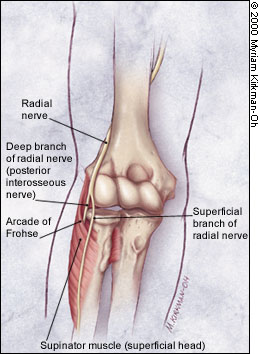Elbow Neurological Conditions: Difference between revisions
No edit summary |
No edit summary |
||
| Line 6: | Line 6: | ||
== Radial Tunnel Syndrome and Posterior Interosseous Nerve Entrapment == | == Radial Tunnel Syndrome and Posterior Interosseous Nerve Entrapment == | ||
[[File:PIN.jpg|frame|300px|Posterior Interosseous Nerve]] | |||
The posterior interosseous nerve is a pure motor branch of radial nerve. Clinical features include deep seated pain within the elbow and weakness of extension of the 3rd, 4th, and 5th digits. | The posterior interosseous nerve is a pure motor branch of radial nerve. Clinical features include deep seated pain within the elbow and weakness of extension of the 3rd, 4th, and 5th digits. | ||
Revision as of 07:34, 21 June 2020
Introduction
The ulnar, radial, and median nerves all tranverse the elbow, and disease processes of the elbow can affect any of these nerves.
Ulnar Neuropathy
Ulnar neuropathy is the most common compressive neuropathy of the elbow. Patients may complain of a weakened grip and clumsy hand. Clinical signs include sensory loss and paraesthesias over the 4th and 5th fingers, and weakness of the interossei.
Radial Tunnel Syndrome and Posterior Interosseous Nerve Entrapment
The posterior interosseous nerve is a pure motor branch of radial nerve. Clinical features include deep seated pain within the elbow and weakness of extension of the 3rd, 4th, and 5th digits.
Radial tunnel syndrome is a theoretical construct where there is entrapment of the radial nerve in the radial tunnel as it passes through the arcade of Frohse in the supinator muscle. There is not much evidence to support this, with only case reports [1]. There are no EMG studies that validate this[2]. MRI studies of patients with RTS usually show no pathology but in some cases they may show muscle edema or atrophy along the distribution of the radial and posterior interosseous nerves (finger extensors, supinator and less, pronator muscles) but the validity of the MRI findings is controversial [3]
See Rinkel et al for a somewhat recent systematic review of the effectiveness of interventions for cubital tunnel syndrome, radial tunnel syndrome, and bursitis of the elbow[4]
Anterior Interosseous Nerve Entrapment
The anterior interosseous nerve is a pure motor branch of the medial nerve. Clinical features include weakness of the flexor digitorum profundus of the 2nd and 3rd fingers. There is no sensory loss, however the patient may report paraesthetic pain at the elbow or over the proximal volar aspect of the forearm.
Neuroma
References
- ↑ Moradi A et al. Arch Bone Jt Surg. 2015 Jul; 3(3): 156–162.
- ↑ van Rossum J et al. Tennis elbow-A radial tunnel syndrome? J Bone Joint Surg Br. 1978;60(2):197–8.
- ↑ Ferdinand BD et al. MR Imaging Features of Radial Tunnel Syndrome: Initial Experience. Radiology. 2006;240(1):161–8.
- ↑ Rinkel WD et al. Current evidence for effectiveness of interventions for cubital tunnel syndrome, radial tunnel syndrome, instability, or bursitis of the elbow: a systematic review. Clin J Pain , 2013, Vol.29(12), p.1087-1096


